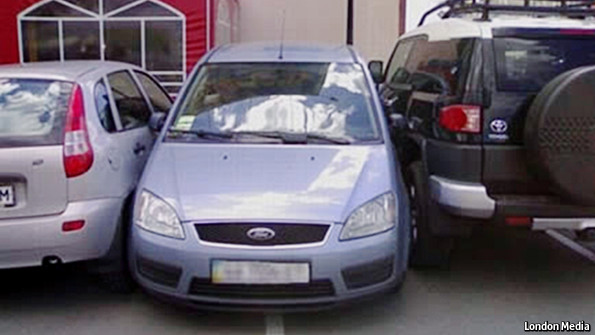Autonomous vehicles are arriving piecemeal, as more and more driving tasks are taken out of human hands

CARS that need no driver are just around the corner according to Google, which has been testing vehicles bristling with aerials and cameras on public roads in America. But Google does not make cars (yet), so it will be up to firms that do to bring the technology to market. And carmakers are a conservative bunch. Still, slowly and steadily the autonomous car will arrive, with the help of an increasing number of automated driving aids. Volvo recently demonstrated one such feature: a car that really does park itself.
Some cars already have systems that assist with parking, but these are not completely autonomous. They can identify an empty parallel-parking space and steer into it while the driver uses the brake. The Volvo system, however, lets the driver get out and use a smartphone application to instruct the vehicle to park. The car then trundles off, manoeuvres into a parking place and sends a message to the driver to inform him where it is. The driver can collect the car in person or use his phone to call it back to where he dropped it off. Autonomous parking could thus be provided at places like shopping centres and airports, which are controlled areas in which automated vehicles can be managed more easily than on open highways.
In the past, designs for doing this have relied on car parks being fitted with buried guide wires that a vehicle can follow to an empty bay. That, though, creates a chicken-and-egg problem: car-park operators will not invest in such infrastructure until there is a sufficient number of suitably equipped cars on the road. Drivers, conversely, will not want to buy self-parking cars if there is nowhere to use them.
This means, as Mikael Thor, a Volvo safety engineer working on the project, observes, that for autonomous parking to work most of the technology will have to be in the car itself. The Volvo test car, which looks like a normal car, therefore uses on-board GPS mapping, cameras with image-recognition software, and radar sensors to find its own way around a car park and avoid pedestrians and non-autonomous vehicles. Mr Thor says the system is five to ten years from commercial deployment. If it proves a success then infrastructure might adapt to it, for instance by packing cars into tighter spaces (with no one in them there is no need to make room for their doors to open), but would not need to anticipate it.
Look, no hands
Driverless cars would also need to communicate with one another, to enhance safety. That, too, is coming. A number of carmakers are developing wireless networking systems through which vehicles can exchange data, such as their speed, their steering angle and even their weight, to forewarn anti-collision systems and safety devices if an accident looks likely.
Ford, for example, recently tested a brake light that can provide an early warning to other motorists. If the brakes are applied hard in an emergency, a signal is broadcast. This illuminates a warning light in the dashboard of suitably equipped following vehicles, even if they are out of sight around a bend or not immediately behind the vehicle doing the braking.
Ford has been testing this system as part of a collaborative research project with several European carmakers. They have put a fleet of 150 experimental vehicles on the roads. When it tested a group of these, Ford found the technology let drivers brake much earlier, helping avoid collisions. A driverless car would be able to react even faster.
Another member of the research group, BMW, has been testing driverless cars on roads around Munich—including belting down some of Germany’s high-speed autobahns. The ordinary-looking BMW 5-series models use a variety of self-contained guidance systems. These include cameras mounted on the upper windscreen, which can identify road markings, signs and various obstacles likely to be encountered on roads.
The BMWs also use a radar, to gauge how far the vehicle is from other cars and potential obstacles, and a lidar, which works like a radar but at optical frequencies. The lidar employs laser beams to scan the road ahead and builds up from the reflections a three-dimensional image of what this looks like. The image is processed by a computer in the vehicle, which also collects and compares data from a high-accuracy GPS unit. A series of ultrasonic sonars similar to those used in vehicles to provide parking assistance are placed around the car to add to the virtual picture. And just to make sure, a set of accelerometers provide an inertial navigation system that double-checks the vehicle’s position on the road.
Although these cars can be switched to an autonomous driving mode, like Google’s vehicles they are still required to have someone in the driving seat who can take over in the event of any difficulty. The BMWs can steer themselves, slow down, brake and accelerate, even changing lanes to overtake slower vehicles. BMW, though, does not yet talk of when it might offer fully autonomous cars to customers; rather it says that it expects to see “highly automated” driving functions available in its models from around 2020.
Policymakers want to see more development before fully autonomous cars are sold to the public. California and a number of other American states have licensed experimental self-driving cars, provided they have someone on board who can take control if needed. For the time being, this is about all that is likely to be allowed. America’s National Highway Traffic Safety Administration said recently that it believes self-driving cars could bring great safety and other benefits, but at this stage it does not think completely autonomous vehicles should be permitted on public roads, other than for testing. Self-parking cars may be one way drivers and regulators gain confidence in the technology.






